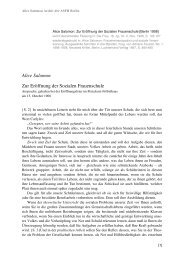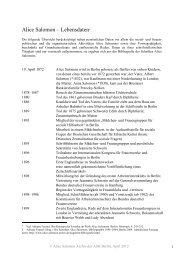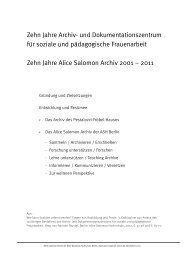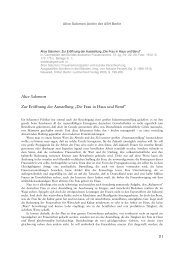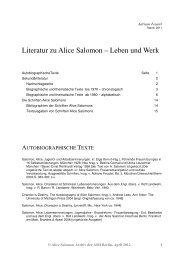Teaching Gender in Social Work - MailChimp
Teaching Gender in Social Work - MailChimp
Teaching Gender in Social Work - MailChimp
Create successful ePaper yourself
Turn your PDF publications into a flip-book with our unique Google optimized e-Paper software.
This may be a start<strong>in</strong>g po<strong>in</strong>t for discover<strong>in</strong>g and reflect<strong>in</strong>g upon the world<br />
of social work and its history – <strong>in</strong> follow<strong>in</strong>g the traces women have left beh<strong>in</strong>d.<br />
These women experienced their entrance <strong>in</strong>to the field of social work as the<br />
discovery of a world that had been unknown and foreign to them, the world of<br />
the work<strong>in</strong>g class and of the outcasts, of poverty and misery. In addition, they<br />
experienced new ways of work<strong>in</strong>g and of help<strong>in</strong>g to change the social situation<br />
<strong>in</strong> general as well as new ways of work<strong>in</strong>g together. F<strong>in</strong>ally but importantly, they<br />
also experienced the bounds of their own female situation mirror<strong>in</strong>g the absence<br />
of fundamental social and political rights. I have tried to expla<strong>in</strong> that reflect<strong>in</strong>g<br />
on social work cannot simply be replaced by putt<strong>in</strong>g forward a scientific theory.<br />
One reason for this is the <strong>in</strong>herent ambivalence of social work, which is so clearly<br />
shown and illustrated by the photographs <strong>in</strong> the album.<br />
Some more po<strong>in</strong>ters for teach<strong>in</strong>g<br />
F<strong>in</strong>ally I would like to give some po<strong>in</strong>ters towards issues and source texts which<br />
can supplement and enlarge upon the discussion of the photos and the photo<br />
album. I will limit these ideas to the two features that have been at the centre<br />
of my presentation and <strong>in</strong>terpretation: the Female <strong>Work</strong>ers’ Club and the keyword<br />
“modernity” <strong>in</strong> the characterisation of the middle-class women’s project<br />
of social work.<br />
Many trails can be followed <strong>in</strong> further teach<strong>in</strong>g related to the photo<br />
album page “Das Arbeiter<strong>in</strong>nenheim” (figures 25 and 39). Some are given here.<br />
The found<strong>in</strong>g of the Female <strong>Work</strong>ers’ Club <strong>in</strong> Berl<strong>in</strong> just before the<br />
turn of the century explicitly picked up on English examples as described<br />
by Alice Salomon <strong>in</strong> several articles, for example, the article “Klubs und<br />
Erholungsheime für jugendliche Arbeiter” (Clubs and recreation centres for<br />
juvenile workers), of 1900. 14 This likewise <strong>in</strong>cludes a po<strong>in</strong>ter towards the<br />
significance of <strong>in</strong>ternational l<strong>in</strong>kage and cooperation <strong>in</strong> which and through<br />
which social work could be substantially developed. This is a thread which<br />
14<br />
Alice Salomon, „Klubs und Erholungsheime für jugendliche Arbeiter,“ Die Jugendfürsorge, 1, no. 9 (1900): 534-<br />
541; repr., Salomon, Frauenemanzipation und soziale Verantwortung, vol. 1(Neuwied: Luchterhand Verlag, 1997):<br />
64-70.<br />
185



